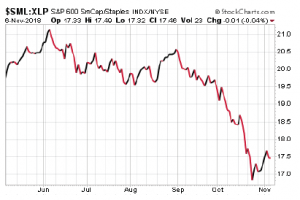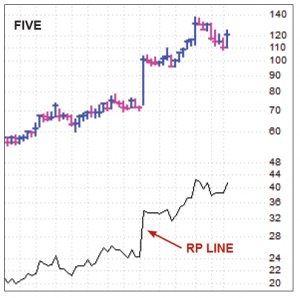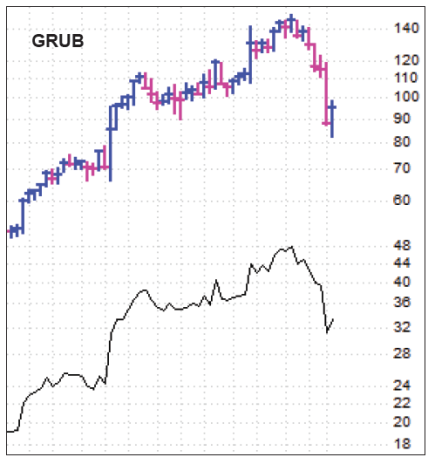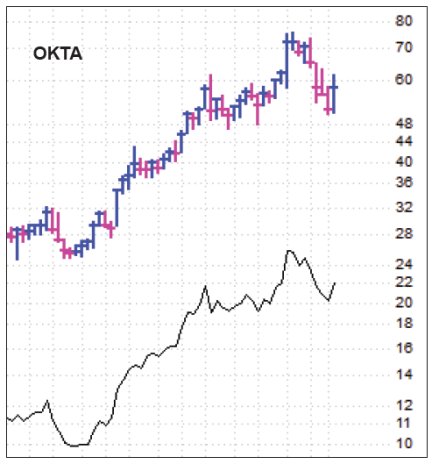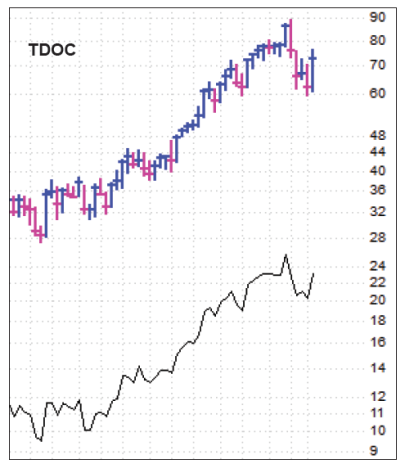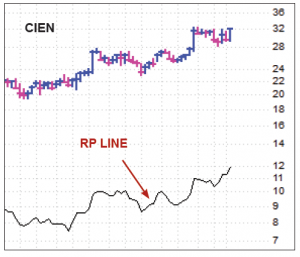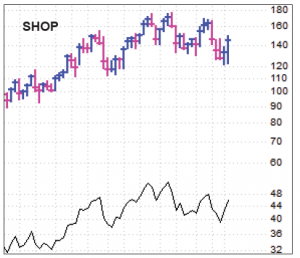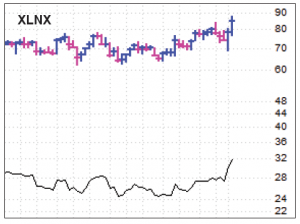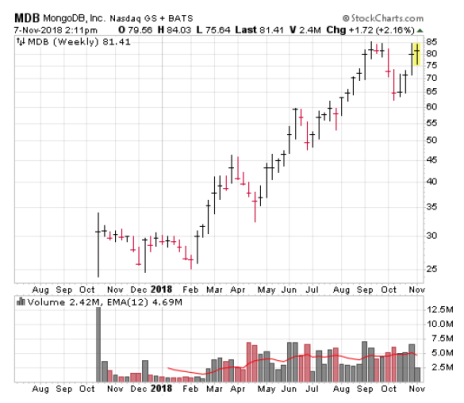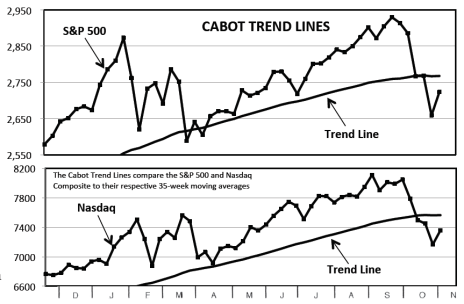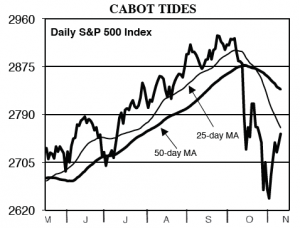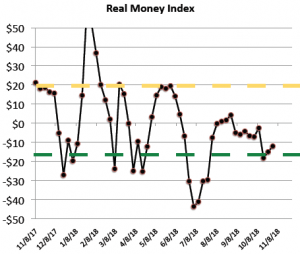The market advanced nicely today, continuing the bounce it’s enjoyed during the past week and a half. It’s encouraging action, and we’re not opposed to doing a little buying here or there given our large (76%) cash position.
That said, our trend-following indicators are still negative, telling us that, despite the nice rally, we need to see continued positive action before starting a major new buying spree. Right now, we’re mostly focused on fine-tuning our watch list, which we’re not having trouble doing given the many strong earnings gaps seen recently.
In tonight’s issue, we talk a bit about how markets usually bottom after a big decline, something that’s good to keep in the back of your mind. And we spend a lot of space discussing potential leaders of the next advance.
Cabot Growth Investor 1406
[premium_html_toc post_id="163625"]
Positive Action, but Need to See More
After a hellacious October that saw many indexes, sectors and stocks crash over a three-week period, the past week and half has been a welcome relief. With today’s solid post-election rally, the S&P 500 and Nasdaq have recouped about half (give or take) of their declines, though small- and mid-cap indexes are further down the ladder.
Said another way, the past week and a half has been a period of stabilization after the October shock—most stocks have held their October lows and begun to rebound, the number of stocks hitting new lows is drying up, more growth stocks have reacted positive to quarterly reports and, more generally, we’re seeing plenty of launching pads form.
All told, we see it as a good start; before a market can go up, it has to stop going down, and that’s what we’ve seen. But is it time to put much money to work? We don’t believe so, for three main reasons.
The first involves our time-tested trend models—even after today’s surge, our Cabot Tides and Cabot Trend Lines are clearly negative. Another week or so of at least slightly positive action could change that, but so far, the trends are still down.
Second, while things have improved, it’s not a huge risk-on environment. The chart shown here displays the relative performance (RP) line of the S&P 600 SmallCap Index (a good measure of the appetite of growth stocks) to the consumer staples fund (symbol XLP, which is a good measure of defensive stocks). After peaking way back in June, the RP line accelerated lower in September and October, and the bounce so far has been minor at best, telling us safety is still a priority for big investors.
And third, there’s history—as we write on page 6, market bottoms are usually (not always) a process, not an event, taking time to wear and scare out all the weak hands.
Put it all together, and we remain defensive, but very much open-minded. We could do a little buying in the near term given our huge cash position, but we need to see more strength before concluding the sellers aren’t hiding in wait.
[highlight_box]WHAT TO DO NOW: Remain defensive, but if you haven’t done so yet, get your watch list ready. In the Model Portfolio, we threw GrubHub (GRUB) overboard last week after its earnings drop, leaving us with 76% in cash. We run through some scenarios for buying on page 2, but tonight, we’re sitting tight.[/highlight_box]
Model Portfolio Update
The Model Portfolio remains in a highly defensive stance, now with 76% in cash after last week’s sale of GrubHub, and only three stocks left. (For newcomers, we usually have 10 to 12 stocks in the portfolio when fully invested, and generally target new positions to be 10% of the account.) While we could raise more cash going forward this is about as defensive as we get unless we’re talking about a 2008-type situation.
Looking ahead, here are a few possible scenarios and how we’d likely react to them—these are obviously rough ideas that could change depending on several factors (like how individual growth stocks are acting), but it’s good to have a road map to be prepared.
1. Renewed downside from here: We’d simply stay defensive. We have no desire to throw money into a meat grinder, even if that means holding a ton of cash. If you want to consider hedging or shorting (say, with an inverse index ETF), that’s fine, but we prefer to keep it simple and just hold cash.
2. Another day of strong-volume upside from here, but no buy signals from our Cabot Tides or Cabot Trend Lines: If combined with solid action among growth stocks (like we saw today), we would probably buy one or two positions (possibly half-sized), but still keep 60%-plus on the sideline. The idea here is to recognize the market’s improved action and (likely) some signs of new leadership by nibbling on a couple of names, but not to expose ourselves to what could morph into a retest or another wave lower (see page 6 about how markets usually bottom out).
3. Higher prices that turns our Tides positive, though the Trend Lines remain negative: Given that we would have already tip-toed into the market (#2 above), a Tides buy signal would likely have us adding another couple of names, bringing our cash to the 45% to 50% area, give or take.
4. Continued strength that sees growth stocks break out and our Trend Lines join the Tides in positive territory: Not surprisingly, we’d probably be buying heavily at this point, following the lead of the stocks we own and looking to buy either powerful breakouts or early-stage pullbacks in new leaders.
The general idea is simple: Preserve capital while the market is in a downtrend, and then step slowly (at first) back into the water once the evidence improves. From there, it’s really a matter of getting “pulled” into a heavily invested stance through the action of the market (and our indicators) and growth stocks.
Right now, though, patience remains the watchword, as we wait to see if this rally can morph into something meaningful.
Current Recommendations
BUY—Five Below (FIVE 122)—FIVE has been choppy on a day-to-day basis, but remains relatively resilient in the big picture, hovering about 11% off its all-time high after a big run; on a net-net basis, all the stock has done is give up its earnings gap from early September. We’ve gotten a few questions recently about the company’s elevated valuation (P/E ratio is about 45 on 2018’s expected earnings of $2.58 per share) and whether that makes FIVE vulnerable to a big selling wave. Our answer: Sure, no stock is completely safe during a market correction, and there are always a bunch of things (market, sector, trade worries) that could lead to selling pressure. However, retail stocks tend to have longer shelf lives (no pun intended) as leaders because, as we’ve written before, their outlooks tend to be relatively reliable—meaning big investors are more willing to pay up for the future. Consider this: FIVE will end this year with around 750 stores, but has a long-term target of 2,500; that’s 3.3 times as many stores that will eventually be up and running. Throw in some margin expansion down the road, and it wouldn’t be unheard of for the bottom line to expand four-fold from this year’s figure ($10 per share or so) if things go according to plan, and this doesn’t include the potential that there could eventually be even more than 2,500 stores. To be clear, we’re not predicting anything, and we’d never buy or sell based on a forecast seven or eight years down the road, anyway. But the point is that it’s possible to see a company like Five Below cranking out 20%-plus earnings growth for many years, and have confidence paying up for some of that today. Long story short, we still have high hopes for FIVE and, while the near term will surely bring volatility, we’re OK picking up a few shares if you’re not yet in.
SOLD—GrubHub (GRUB 94)—We threw in the towel with our remaining shares of GrubHub early last week. Yes, the story remains intact, and management’s move to increase spending on marketing and other business activities isn’t a bad thing, per se. But at some point you have to look at the stock’s action and assume that some in-the-know investors are looking ahead to slowing growth—GRUB plunged below its long-term 40-week line on gigantic volume after earnings, and has failed to bounce much since. Even if the stock is “wrong” and business remains in fine shape, it’s clear that investor perception (which is a main driver of stocks) has turned down after a long run. If the stock sets up again and growth proves durable (analysts see earnings up 17% next year, a big slowdown from recent rates), we could always take another look. But after a brutal decline, GRUB likely needs plenty of time to repair the damage, and we think there will be better stocks to own during the next uptrend.
HOLD—Okta (OKTA 63)—The cloud software sector did very well for most of this year, but during the correction most names in the group—whether you’re talking emerging blue chips like ServiceNow (NOW) or glamour stocks like Coupa Software (COUP) and Okta—declined toward their 200-day lines before today’s powerful, broad-based rally. The question is whether select names in the sector (especially early-stage ones like OKTA) can rev up again during the market’s next uptrend. We remain optimistic because, while the broad cloud software story is relatively well known at this point (meaning there are fewer potential buyers for the bigger names), many of the niche areas like identity solutions from OKTA and, for that matter, spending management from COUP, are still being discovered by investors. Back to the stock, OKTA isn’t the prettiest chart in the world, but it held support above its 200-day line (which is now above 50 and crawling higher) and within its prior base from this summer, while today’s big-volume rally brought it back to its 50-day line. Looking ahead, a break of the 200-day line and its recent lows would knock us out, but we’re content to give the stock room to wiggle around, thinking the potential upside remains big during the next market uptrend.
HOLD—Teladoc (TDOC 68)— Teladoc reported earnings last Thursday evening, and they confirmed that its business is very much on track. Q3’s top line grew a strong 60% (up 29% excluding the purchase of Advance Medical), driven by both subscription and visit fee revenue gains. And while organic paid membership was up just 12% (or 18% including acquisitions), member usage is going up nicely, with visits from paid members up 44% from a year ago and international visits now making up about one-quarter of the total. The top brass also nudged up revenue estimates for Q4. The stock initially reacted positively, but then sank sharply on Monday, supposedly due to some worries surrounding its newer behavioral health offerings, which have driven a good amount of its organic growth in recent quarters. We highly doubt that’s a big issue, and instead think the dive was “only” a matter of big investors lightening up as the stock ran into resistance; today’s bounceback was an encouraging sign. That said, we’re not whistling past the graveyard, either—a meaningful break below the stock’s October low (just under 60) would probably have us selling to make sure a bad situation doesn’t get worse. Given our huge cash position, we’re OK giving the stock a little rope, but we’ll be watching closely.
Watch List
Ciena (CIEN 35): CIEN actually has surged to new price highs this week on excellent volume, breaking out of a two-month structure (which itself formed on top of a three-year consolidation). See page 5 for more.
Dexcom (DXCM 145): DXCM reported another terrific quarter last night, with revenue growth accelerating again (up 44%), a surprise profit (14 cents per share vs. 9 cent loss expected) and a meaningfully higher outlook for Q4. The stock was volatile, but briefly rose back to its September peak before backing off a bit. If it settles down and the market turns positive, DXCM could be a leader again.
Etsy (ETSY 50): ETSY was looking just so-so, but the stock soared today after Q3 results—sales were up 41% (accelerating rapidly from 30% and 25% the prior two quarters), cash flow was up 50% and gross merchandise value sold on its platform rose 21%. The stock still has some overhead to chew through, but the firm’s unique position in the homemade goods segment should keep growth humming for a long time.
Exact Sciences (EXAS 75): EXAS has given up none of its earnings pop from last week—in fact, the stock has put together 10 of 13 days on the upside, a rare show of resilience in this market. Growth is likely to remain brisk, and the Pfizer deal looks like a game changer for investor perception.
HealthEquity (HQY 100): HQY corrected “only” 19% during the market downturn and is back to within a stone’s throw of its peak. We see the market for health savings accounts offering the combination of long-term growth and predictability that big investors love. And HQY is the best way to invest in that trend.
MongoDB (MDB 82): MongoDB (the name is short for “humongous database”) offers a new-age database platform that’s enjoying rapid adoption. See page 7 for more.
Tesla (TSLA 348): We remain very encouraged by TSLA, which has built on its excellent post-earnings reaction in recent days. While most are caught up in the firm’s superficial news, we think the Q3 report may be a turning point and launch a solid “reality phase” as margins perk up and earnings boom (nearly $6 per share estimated for 2019).
Twilio (TWLO 96): Twilio wowed the market last night with a much better-than-expected report that caused the stock to go ballistic today. Revenue growth accelerated wildly (up 68% vs. 54%, 48% and 41% the prior three quarters), earnings of 7 cents per share were above the two-cent estimate, while all of the sub-metrics (customers up 32%, revenue per customer up 27%, renewal rates through the roof) were encouraging. We think TWLO has emerging blue chip written all over it.
Other Stocks of Interest
The stocks below may not be followed in Cabot Growth Investor on a regular basis. They’re intended to present you with ideas for additional investment beyond the Model Portfolio. For our current ratings on these stocks, see Updates on Other Stocks of Interest on the subscriber website or email mike@cabotwealth.com.
Ciena (CIEN 35) — Ciena’s fiber-optic communications products work on the system level of communication networks and data centers and help enable the biggest trends in technology, including 5G, cloud, data center and Internet of Things (IoT). These trends demand high bandwidth and fast data transfer, and Ciena’s products deliver. The company’s Q3 earnings report featured 12% revenue growth (the fastest in years) and 37% earnings growth (the fastest since Q1 2016). Ciena is expanding globally, especially in India and Japan, at a time when internet companies are having to spend heavily on new equipment to stay competitive. Analysts see earnings up 34% next year, a continued acceleration in growth. CIEN broke past its long-term resistance in late August after a blockbuster quarterly report and, despite the market’s wobbles, is trading at its highest level since 2008. This looks like a new leader.
Keurig Dr Pepper (KDP 28) — Consumer staples isn’t usually a sector that provides hot stocks, but Keurig Dr Pepper may be the exception. The company is the result of the March merger of coffee giant Keurig and the beverage giant Dr Pepper, whose brands include 7-Up, Dr Pepper, A&W, Canada Dry, Schweppes and various tea and juice products. Revenue growth in this industry is notoriously slow (3% in 2015 and 2016 and 4% in 2017), but the company’s strategy of combining national brands with regional favorites and maximizing synergies from the merger has earned the stock coverage from three new analysts since July. Big picture, management believes cash flow and earnings can grow in the low- to mid-double digits for the next few years, which should keep investors interested. A 2.3% dividend adds a bit more attraction.
Shopify (SHOP 148) — Shopify’s success in helping small and medium-sized businesses get online via its cloud-based commerce platform made it a monster stock for much of last year and early this year. But it’s been a much choppier ride this year, with some nice ups (as high as 177 in July) but a ton of sharp corrections as well—as of two weeks ago, in fact, the stock hadn’t made any net progress since September of last year! So the question is whether the stock’s many gyrations have worn out enough weak hands to clear the way for further advances. We think it may have, as the story is still good, and the company’s aggressive investment in growth continues to pay off (revenues up 58% in Q3; analysts see earnings more than doubling next year). It’s worth keeping an eye on to see if SHOP can continue its big-picture run that started early last year.
Xilinx (XLNX 85) — Xilinx has always been a technology leader in microchip design, but its stock hasn’t always matched the performance of its chips. But XLNX actually held up pretty well to the selloff in tech stocks this year. And since the company’s quarterly report on October 24 beat on both revenue and earnings and raised its guidance for next quarter’s results far ahead of what analysts expected, the stock has been red hot. XLNX, which had just dipped from above 80 as October began to 69 on earnings day, took just six days to run to new highs at around 87. With a new class of processors (called Adaptive Compute Acceleration Platform) buttressing the company’s competitive position against Nvidia, the future for Xilinx looks bright. Today’s dip, caused by an acquisition rumor, looks normal.
Bottoms are Usually a Process, Not an Event
One of our favorite passages we’ve read came in a book called The Perfect Speculator, when a fictional investor was teaching a disciple about the market: “I mentioned somewhere that everything in the market takes time. It takes time to make or lose big money. It takes time for a stock to set up its play before making its move. During the course of its set-up, many times a stock will offer many false signals. It will demand patience from the speculator.”
In other words, despite all the day-to-day movement, stocks (and the overall market) tend to do a lot of setting up before moving in a sustained up (or down) trend. And we particularly see that when the market is trying to etch a low—while most investors envision a market hitting bottom and immediately reversing higher, in reality meaningful bottoms tend to be a process, taking a few weeks, rather than an event, which takes a few hours.
The reason: It takes time for weak hands to be scared out or worn out, and it takes time for institutional investors to reposition their holdings (getting out of old leaders and into new ones). Note that we’re not talking about minor pullbacks of 3% or 4% in the major indexes, but meaningful downturns like the one we’ve just experienced.
What about the much-talked-about V bottoms? Occasionally it can happen—the action after 9/11 showed a successful V bottom, as did the action in October 2014 following the Ebola scare (though the ensuing rally was just so-so). But these type of lows tend to be less reliable and shorter-lasting than those that form over at least a few weeks.
The action from February of this year provides a good example. The major indexes staged a quick collapse during the “short volatility” panic, with the Nasdaq plunging 12% in just a couple of weeks. And what happened next? A V-shaped rebound, which actually took the index back to new highs and got everyone excited again!
But you see what happened next—another sharp correction that took the Nasdaq back near its February low and finally whacked most growth stocks. After this dip, notice how the Nasdaq bottomed out for more than a month, which led to a solid three-month rally.
Of course, we’d never tell the market what to do—if a V-shaped recovery gets underway and our trend-following indicators turn green, we’ll go along with it (through we’ll probably step into the market more slowly than we would otherwise). But it’s a good thing to keep in mind that, following big declines, bottoms tend to be a process—a process that, ideally, the market began last week.
Two Kinds of Fresh Names
What do stocks like Square, Shopify, Veeva Systems, Five Below, Ollie’s Bargain Outlet, Zendesk, GrubHub and Universal Display have in common? All of them had big runs some time during the 2017-2018 bull move—but none of them were familiar to the vast majority of investors 18 months ago. That’s not a surprise, as new advances tend to feature new leadership that hasn’t been “overplayed” during the prior upcycle.
It’s probably going to be the same story when we come out of this correction—while some popular stocks might regain their glory, the odds favor newer leaders taking the baton. There are two kinds of new leaders: Older companies that are emerging after a long rest (often because something new and exciting is going on at the firm). Examples include Exact Sciences (EXAS), Tesla (TSLA) and networker Ciena (CIEN—written about on page 4), all of which are on our watch list.
The other place to look is among stocks that have come public during the past year or two. One idea we’re keeping an eye on is MongoDB (MDB), which came public in October 2017 and originally broke out in March of this year. Fundamentally, while the story can give you a bit of an ice cream headache, the overarching idea is simple: MongoDB (name is short for humongous database) is aiming to revolutionize the database field, able to incorporate document-based data (instead of rows/columns), unstructured and machine (automatically produced) data and holding much larger amounts of data.
Basically, it’s a better mousetrap for developers, offering them the best way to work with data, put data where it’s needed (often closer to customers for quicker app speeds) and even comply with regulatory demands when managing their data. There is competition, but Mongo sees itself as the clear modern database platform of the future, and customers have been beating a path to its door (revenues up 50% to 60% each quarter); it has 7,400 clients, up 72% from a year ago.
What’s really impressive is that MDB had a huge run this year, running from its breakout near 32 to a high of 85 in September. While it did get hit early last month, it’s bounced back nicely and isn’t far from new high ground. MDB is just the type of little-known, fast-growing, resilient name that could do well during the next bull move. WATCH.
Cabot Market Timing Indicators
The market has bounced nicely, and in the Model Portfolio we’re not opposed to nibbling on a name or two if we see a bit more strength. But with the overall trend still down, it’s best to hold a bunch of cash until we see some buy signals.
Cabot Trend Lines: Bearish
Our Cabot Trend Lines remain negative, with the S&P 500 (by 1.6%) and Nasdaq (by 2.7%) both closing below their respective 35-week moving averages last week. A fresh buy signal going forward would be encouraging, but that would require (a) a push above both 35-week lines and (b) two straight weekly closes above them for each index. Anything’s possible, but until proven otherwise, the market’s longer-term uptrend has been broken.
Cabot Tides: Bearish
Our Cabot Tides are also firmly bearish—while some of the indexes we track (including the bellwether S&P 500, daily chart shown here) have moved above their lower (now 25-day) moving averages, those moving averages themselves are still moving lower. It would probably take another week of holding these gains before the Tides could flip to bullish. Bottom line, both of the market’s major trends are pointed down, which argues for a defensive posture.
Cabot Real Money Index: Neutral
Our Real Money Index has returned to neutral territory after a green light from three weeks ago. Those signals usually lead to solid gains during the next month or two, so we’ll see how things paly out, but it’s fair to say that this time around the market’s extreme selloff (and negative trends) overwhelmed the brief bout of panic. We’ll be watching for any further green lights.
[premium_html_footer]
Send questions or comments to mike@cabotwealth.com.
Cabot Growth Investor • 176 North Street, Post Office Box 2049, Salem, MA 01970 • www.cabotwealth.com
All Cabot Growth Investor’s buy and sell recommendations are made in issues or updates and posted on the Cabot subscribers’ website. Sell recommendations may also be sent to subscribers as special bulletins via email and the recorded telephone hotline. To calculate the performance of the portfolio, Cabot “buys” and “sells” at the midpoint of the high and low prices of the stock on the day following the recommendation. Cabot’s policy is to sell any stock that shows a loss of 20% in a bull market (15% in a bear market) from our original buy price, calculated using the current closing (not intra-day) price. Subscribers should apply loss limits based on their own personal purchase prices.
Charts show both the stock’s recent trading history and its relative performance (RP) line, which shows you how the stock is performing relative to the S&P 500, a broad-based index. In the ideal case, the stock and its RP line advance in unison. Both tools are key in determining whether to hold or sell.
THE NEXT CABOT GROWTH INVESTOR WILL BE PUBLISHED NOVEMBER 20, 2018
We appreciate your feedback on this issue. Follow the link below to complete our subscriber satisfaction survey: Go to: www.surveymonkey.com/marketlettersurvey
Neither Cabot Wealth Network nor our employees are compensated by the companies we recommend. Sources of information are believed to be reliable, but are in no way guaranteed to be complete or without error. Recommendations, opinions or suggestions are given with the understanding that subscribers acting on the information assume all risks. © Cabot Wealth Network. Copying and/or electronic transmission of this report is a violation of U.S. copyright law. For the protection of our subscribers, if copyright laws are violated, the subscription will be terminated. To subscribe or for information on our privacy policy, call 978-745-5532, visit www.cabotwealth.com or write to support@cabotwealth.com.
[/premium_html_footer]


